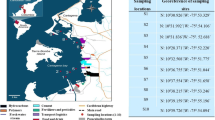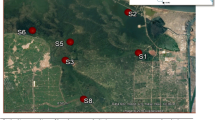Abstract
The concentrations of three groups of organochlorine compounds (HCCH, DDT, and PCB) in bottom sediments, zebra mussel, and two fish species—zope and roach—in the Volga Pool of the Rybinsk Reservoir. The concentrations of the examined toxicants can be ranked in the ascending order as follows: HCCH<DDT<PCB. The total concentration of organochlorine compounds (OCC) and their metabolites are very low, thus allowing the Volga Pool to be regarded as a background region for the Upper and Middle Volga Basin. A congener-specific determination of PCB was carried out, and priority congeners were identified for monitoring the ecosystem pollution by dioxin-like compounds.
Similar content being viewed by others
References
Arinushkina, E.V., Rukovodstvo po khimicheskomu analizu pochv (Handbook on Chemical Analysis of Soils), Moscow: Mosk. Gos. Univ., 1961.
Afanas’ev, M.I., Buivolov, Yu.A., Vulykh, N.K., and Zagruzina, A.N., Background Concentration of Organochlorine Pesticides and Polychlorinated Biphenyls in Natural Media. Report 6, in Monitoring fonovogo zagryazneniya prirodnykh sred (Monitoring Background Pollution of Natural Media), Leningrad: Gidrometeoizdat, 1991, issue 7, pp. 57–80.
Bikbulatov, E.S., Bikbulatova, E.M., and Grigor’eva, E.R., Determination of Total Phosphorus in Suspended Matter of Natural Waters, Inform. Byul. “Biologiya Vnutrennikh Vod”, 1978, no. 38, pp. 83–86.
Vasil’ev, L.I., On the Growth of Zope in the Rybinsk Reservoir, Tr. Biol. St. “Borok”, 1955, no. 2, pp. 301–306.
German, A.V. and Zakonnov, V.V., Accumulation of Polychlorinated Biphenyls in the Sheksninskii Pool of the Rybinsk Reservoir, Vodn. Resur., 2003, vol. 30, no. 5, pp. 571–575 [Water Resour. (Engl. Transl.), vol. 30, no. 5, pp. 524–528].
Grosheva, E.I. and Surnina, N.N., Polychlorinated Hydrocarbons in Lake Baikal Ecosystem, Ekologiya, 1998, no. 4, pp. 324–326.
Kas’yanov, A.N., Izyumov, Yu.G., and Kas’yanova, N.V., Linear Growth of Roach Rutilus rutilus in Water Bodies of Russia and Nearby Countries, Vopr. Ikhtiol., 1995, vol. 35, no. 6, pp. 772–781.
Kozlovskaya, V.I. and German, A.V., Polychlorinated Biphenyls and Polyaromatic Hydrocarbons in the Ecosystem of the Rybinskoe Reservoir, Vodn. Resur., 1997, vol. 24, no. 5, pp. 563–569 [Water Resour. (Engl. Transl.), vol. 24, no. 5, pp. 520–526].
Maier, F.L., Peti, Dzh.D., Kozlovskaya, V.I., and Flerov, B.A., Determination of Residual Amounts of Pesticides in Fish of the Rybinsk Reservoir, Gidrobiol. Zh., 1981, no. 5, pp. 83–87.
Mel’nikov, N.N., Khimiya i tekhnologiya pestitsidov (Chemistry and Technology of Pesticides), Moscow: Khimiya, 1974.
Pavlov, D.F. and Bakin, A.N., Organochlorine Pesticides in Inland Water Bodies of Russia: Literary Review and the Authors’ Data, Aktual’Nye Problemy Vodnoi Toksikologii. Borok (Urgent Problems of Water Toxicology) 2004, pp. 150–175.
Polikhlorirovannye bifenily (PKhB) v Baikal’skom regione: istochniki, dal’nii perenos i otsenka riska (rezul’taty granta INTAS 2000-00140) (Polychlorinated Biphenyls (PCB) in Baikal Region: Sources, Long-Distance Transport, an Risk Assessment (Results of Grant INTAS 2000-00140), Kuz’min, M.I., Ed., Irkutsk: Inst. geografii SO RAN, 2005.
Proekt “Volga” v Cherepovtse (“Volga” Project in Cherepovets), Nizhnii Novgorod: Ekologicheskii tsentr “Dront”, 1996.
Sovremennoe sostoyanie ekosistemy Sheksninskogo vodokhranilishcha (Current State of Sheksna Reservoir Ecosystem), Yaroslavl: Izd. YaGTU, 2002, p. 368.
Stepanova, N.Yu., Govorkova, L.K., Anokhina, O.K., and Latypova, V.Z., Assessment of Bottom Sediments Pollution Level of the Kuibyshev Reservoir in the Sites of Higher Anthropogenic Load by Triad Method, Aktual’Nye Problemy Vodnoi Toksikologii. Borok (Urgent Problems of Water Toxicology), 2004, pp. 224–247.
Strekozov, B.P., Sukhoparova, V.P., Sokolov, O.A., et al., Ecological-Toxicological State of Agrolandscapes in the Oka Floodplain, Izv. Akad. Nauk, Ser. Biol., 1995, no. 1, pp. 87–96.
Author information
Authors and Affiliations
Additional information
Original Russian Text © A.V. German, V.V. Zakonnov, A.A. Mamontov, 2010, published in Vodnye Resursy, 2010, Vol. 37, No. 1, pp. 87–91.
Rights and permissions
About this article
Cite this article
German, A.V., Zakonnov, V.V. & Mamontov, A.A. Organochlorine compounds in bottom sediments, benthos, and fish in the volga pool of the Rybinsk Reservoir. Water Resour 37, 84–88 (2010). https://doi.org/10.1134/S0097807810010082
Received:
Published:
Issue Date:
DOI: https://doi.org/10.1134/S0097807810010082




